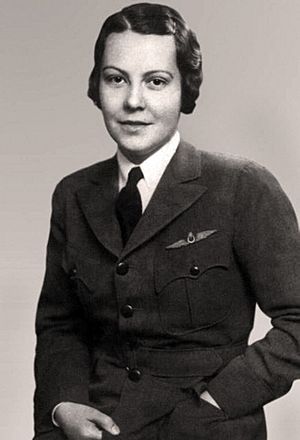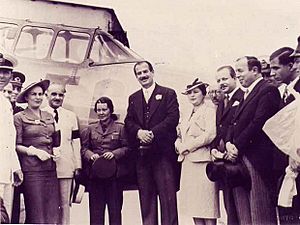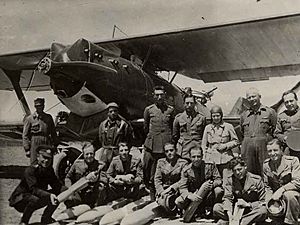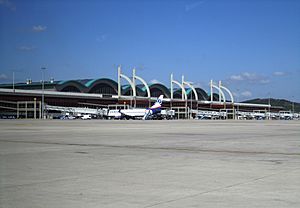Sabiha Gökçen facts for kids
Quick facts for kids
Sabiha Gökçen
|
|
|---|---|

A photo of Sabiha Gökçen from the 1930s
|
|
| Born | 22 March 1913 Bursa, Hüdavendigâr Vilayet, Ottoman Empire
|
| Died | 22 March 2001 (aged 88) |
| Resting place | Cebeci Askerî Şehitliği, Ankara |
| Nationality | Turkish |
| Alma mater | Üsküdar American Academy |
| Occupation | Aviator, author and spokesperson |
| Known for | World's first female fighter pilot |
| Spouse(s) | Kemal Esiner (1940–1943) |
| Parent(s) | Mustafa İzzet Bey and Hayriye Hanım |
| Awards | FAI Gold Air Medal |
Sabiha Gökçen (22 March 1913 – 22 March 2001) was a brave Turkish pilot. She flew for about 8,000 hours and took part in 32 different military missions. At just 23 years old, she became the world's first female fighter pilot. Sabiha was an orphan and was one of nine children adopted by Mustafa Kemal Atatürk, the founder of modern Turkey.
The Guinness Book of World Records recognizes her as the first female combat pilot. In 1996, the United States Air Force chose her as the only female pilot for their poster, "The 20 Greatest Aviators in History".
Sabiha Gökçen Airport, a major airport in Istanbul, is named after her.
Contents
Sabiha's Early Life

Sabiha Gökçen was born to Mustafa Izzet Bey and Hayriye Hanım. Her family had roots in Bosnia. In 1925, when Sabiha was twelve, she met Atatürk during his visit to Bursa. She told him she wanted to study at a boarding school.
Atatürk learned about her difficult life. He decided to adopt her and brought her to the Çankaya Presidential Residence in Ankara. Sabiha lived there with Atatürk's other adopted daughters, Zehra, Afet, and Rukiye. She went to Çankaya Primary School in Ankara and the Üsküdar American Academy in Istanbul.
In 1934, Turkey introduced the Surname Law. Atatürk gave her the last name Gökçen. 'Gök' means sky in Turkish, and Gökçen means 'belonging to the sky'. This was before she even started flying! Six months later, Sabiha became very interested in aviation.
Becoming a Pilot
Atatürk believed that aviation was very important for Turkey. He helped create the Turkish Aeronautical Association in 1925. On May 5, 1935, he took Sabiha to the opening of the Türkkuşu (Turkish Bird) Flight School.
During an airshow with gliders and parachutists, Sabiha felt very excited. Atatürk asked her if she wanted to become a skydiver. She quickly said, "Yes, I am ready right now!" Atatürk told the school's head to enroll her as the first female student.
Sabiha was supposed to be a skydiver, but she loved flying airplanes more. So, she worked hard and earned her pilot's license. She and seven male students went to Crimea, in the Soviet Union, for advanced training. She learned to fly gliders and powered aircraft. Sadly, while she was there, her sister Zehra died. Sabiha returned to Turkey feeling very sad.
After some time, Atatürk encouraged Sabiha to start flying again. She received special training at Eskişehir Aviation School. On February 25, 1936, she flew a motorized airplane for the first time.
Atatürk was very proud of her success. He told her, "You have made me very happy. Perhaps you will be the first woman military pilot in the world. For the world's first military woman pilot to be Turkish would be a proud event." He then sent her to the Tayyare School in Eskişehir for special training.
At that time, girls were not allowed in the Turkish War Academies. So, Atatürk arranged for Sabiha to have a special uniform and a unique eleven-month training program. She studied at the Tayyare Mektebi (Aviation School) in Eskişehir from 1936 to 1937. After getting her pilot's diploma, she trained for six months to become a war pilot.
She practiced flying bomber and fighter planes at the 1st Aircraft Regiment in Eskişehir Airbase. She gained experience in military exercises over the Aegean and Thrace in 1937. That same year, she took part in military operations during the Dersim rebellion. This made her the first Turkish female air force combat pilot. She was recognized for her bravery during these operations. She also received the Turkish Aeronautical Association's first "Murassa (Jeweled) Medal" for her excellent performance.
In 1938, Sabiha flew for five days around the Balkan countries. Her flights were highly praised. In the same year, she became the chief trainer at the Türkkuşu Flight School. She worked there as a flight instructor until 1954 and was also on the association's executive board. She trained four other female pilots: Edibe Subaşı, Yıldız Uçman, Sahavet Karapas, and Nezihe Viranyalı. Sabiha Gökçen continued flying for 28 years until 1964. In 1981, her book A Life Along the Path of Atatürk was published.
Legacy and Recognition
The Sabiha Gökçen International Airport in Istanbul is named after her. It opened on January 8, 2001, just ten weeks before she passed away.
The Guinness Book of World Records officially recognizes her as the first female combat pilot.
In 1996, the United States Air Force chose her as the only female pilot for their poster, "The 20 Greatest Aviators in History".
That same year, she was honored at the Air Command and Staff College's Gathering of Eagles at Maxwell Air Force Base. This program celebrates aviation pioneers and encourages the study of flight history.
On March 22, 2009, a Google Doodle honored her birthday in Turkey.
Death
Sabiha Gökçen died from heart failure at the age of 88. She passed away at Gülhane Military Medical Academy on March 22, 2001.
Awards and Medals
Sabiha Gökçen received many honors for her amazing career:
- The Number one Medal of Övünç (Murassa) and a certificate from the Turkish Aeronautical Association.
- The Badge of the White Eagle, the highest badge given by the Yugoslav Army.
- The Romanian Army Aviation Badge.
- Commemorative medals for the Thracian and Aegean maneuvers.
- A plaque for pioneer women in their professions, given at the Turkish Grand National Assembly.
- An Honorary Doctor degree from Selcuk University.
- A gold medal from THK in 1989.
- The FAI gold medal from the International Aviation Federation in 1991.
- The title of "one of the 20 aviators who made their mark in world history" in 1996.
- 28 plaques from the army and various organizations.
Images for kids
-
Mustafa Kemal Atatürk, Ali Çetinkaya and Sabiha Gökçen in Diyarbakır
See also
 In Spanish: Sabiha Gökçen para niños
In Spanish: Sabiha Gökçen para niños
- Bedriye Tahir Gökmen
- Ahmet Ali Çelikten
- List of firsts in aviation










